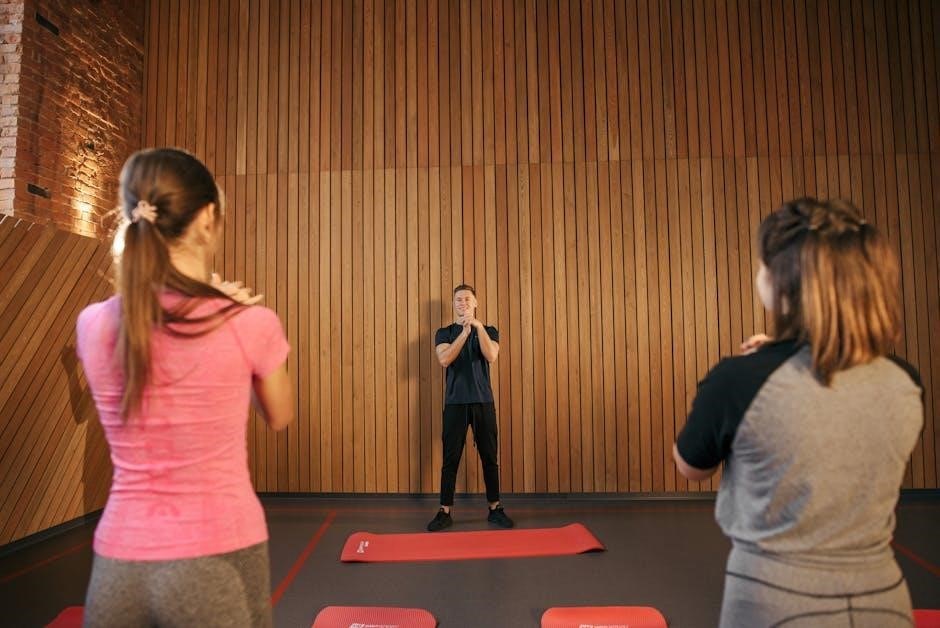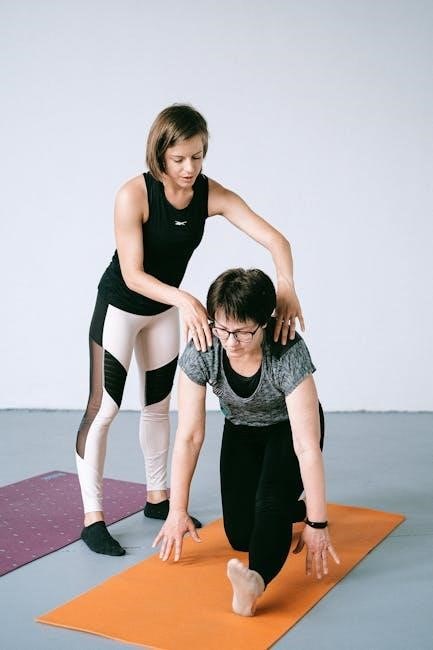
Living with fibromyalgia can be challenging, but incorporating exercise can offer significant relief. This guide provides general information about exercise and fibromyalgia. Remember, this doesn’t replace individual medical advice. Managing your health with fibromyalgia involves physical activity and education; Begin your journey toward a more active life today!

Understanding Fibromyalgia and its Symptoms

Fibromyalgia is a chronic condition characterized by widespread musculoskeletal pain accompanied by fatigue, sleep disturbances, and cognitive difficulties. People with fibromyalgia often experience heightened sensitivity to pain, a phenomenon known as allodynia, where even light touch can be painful. The exact cause of fibromyalgia remains unknown, but it is believed to involve a combination of genetic predisposition, environmental factors, and psychological stressors.
The symptoms of fibromyalgia can vary in intensity and fluctuate over time, making it a challenging condition to manage. Common symptoms include persistent muscle aches, stiffness, and tenderness, particularly in specific areas of the body known as tender points. Fatigue is another prominent symptom, often described as overwhelming exhaustion that is not relieved by rest.
Sleep disturbances, such as insomnia and restless legs syndrome, are also common among individuals with fibromyalgia. Cognitive difficulties, often referred to as “fibro fog,” can include problems with memory, concentration, and attention. These symptoms can significantly impact daily functioning and quality of life. Understanding these multifaceted symptoms is crucial for tailoring effective exercise programs.
Effective management often involves a multidisciplinary approach, integrating exercise, medication, and lifestyle adjustments to alleviate pain and improve overall well-being. Recognizing the complexities of fibromyalgia is the first step toward developing a comprehensive exercise strategy.

Benefits of Exercise for Fibromyalgia
Exercise is a vital, non-pharmacological treatment for fibromyalgia. Studies show many ways to benefit from physical activity, including land- or water-based programs. Exercise can help maintain or improve functional capacity, with resultant benefits for day-to-day activities and enhanced quality of life.
Pain Reduction through Exercise

Many individuals with fibromyalgia experience increased pain when starting an exercise program, which can be discouraging. However, consistent physical activity is often the best approach for long-term pain management. Functional exercise training, in particular, has demonstrated effectiveness in reducing pain in patients with fibromyalgia. This type of training focuses on movements used in daily life, making it easier to perform everyday tasks with less discomfort.
Exercise stimulates the release of endorphins, which are natural pain relievers produced by the body. These endorphins can help to counteract the chronic pain associated with fibromyalgia, providing a sense of well-being and reducing the reliance on pain medication. Furthermore, regular exercise can improve sleep quality, which in turn can reduce pain levels. Poor sleep is a common symptom of fibromyalgia, and addressing it through exercise can create a positive feedback loop, where better sleep leads to less pain and improved ability to exercise.
It’s crucial to start slowly and gradually increase the intensity and duration of exercise to avoid exacerbating pain. Consulting with a physical therapist or healthcare professional can help create a personalized exercise plan that addresses individual needs and limitations. With patience and consistency, exercise can become a powerful tool for managing and reducing pain associated with fibromyalgia.

Improved Functional Capacity with Physical Activity
Fibromyalgia significantly impacts functional capacity, making everyday tasks challenging. Physical exercise emerges as a vital therapy to help maintain and/or improve it, with resultant benefits for day-to-day activities. Engaging in regular physical activity can enhance your ability to perform routine tasks, such as walking, lifting, and bending, with greater ease and less fatigue. This improvement stems from increased muscle strength, flexibility, and overall endurance.
Exercise helps to combat the deconditioning that often accompanies chronic pain conditions like fibromyalgia. Deconditioning leads to muscle weakness and reduced cardiovascular fitness, further limiting functional capacity. By participating in exercise programs, individuals with fibromyalgia can reverse this process, building strength and stamina to improve their ability to participate in daily life. Both land-based and water-based exercises have been shown to be effective in improving functional capacity.
Moreover, exercise can improve balance and coordination, reducing the risk of falls and injuries. This is particularly important for individuals with fibromyalgia, who may experience muscle stiffness and pain that can affect their stability. Functional exercise training, which mimics real-life movements, is particularly beneficial for improving functional capacity. By focusing on exercises that directly translate to everyday activities, individuals with fibromyalgia can regain independence and improve their overall quality of life.
Enhancing Quality of Life via Exercise
Exercise is not only about physical benefits; it significantly enhances the overall quality of life for individuals with fibromyalgia. Studies show that engaging in regular physical activity can lead to improvements in mood, sleep, and overall well-being. The positive impact on mental health is particularly crucial, as fibromyalgia often co-occurs with anxiety and depression. Exercise releases endorphins, which have mood-boosting effects and can help alleviate symptoms of these conditions.
Improved sleep quality is another key benefit of exercise. Many people with fibromyalgia struggle with insomnia or restless sleep, which can exacerbate pain and fatigue. Regular physical activity can help regulate sleep patterns, leading to more restful and restorative sleep. This, in turn, can improve energy levels and reduce pain sensitivity throughout the day. Exercise can also foster a sense of accomplishment and control over one’s health, which is empowering for individuals managing a chronic condition.
Furthermore, exercise can enhance social interaction and reduce feelings of isolation. Participating in group exercise classes or activities can provide opportunities to connect with others who understand the challenges of living with fibromyalgia. This social support can be invaluable in coping with the emotional and psychological aspects of the condition. Ultimately, exercise empowers individuals with fibromyalgia to take an active role in their own well-being, leading to a more fulfilling and meaningful life.

Types of Exercise Suitable for Fibromyalgia
Many types of exercise can help with fibromyalgia, from walking to swimming. Select a program that works for you. Explore land-based and water-based options. Yoga, Tai Chi, and Pilates are also low-impact choices. Find what you enjoy!
Land-Based Exercises for Fibromyalgia
Land-based exercises offer a versatile approach to managing fibromyalgia symptoms. Daily walks are a great starting point, promoting cardiovascular health and muscle engagement. Incorporate stretching routines to improve flexibility and reduce stiffness. Strength training, when approached cautiously, can help build muscle strength and support joints.
Consider functional exercise training, which focuses on movements used in everyday life. This type of training can be effective at reducing pain and improving overall quality of life. Remember to listen to your body and avoid overexertion, especially when starting a new program.
Consult with a physical therapist or certified trainer who has experience working with individuals with fibromyalgia. They can help you develop a personalized exercise plan that meets your specific needs and limitations. Consistency is key, so aim for regular exercise sessions, even if they are short and gentle. Combining different types of land-based exercises can provide a well-rounded approach to managing your symptoms and improving your overall well-being. Start slowly and gradually increase the intensity and duration of your workouts as your body adapts.
Water-Based Exercises for Fibromyalgia
Water-based exercises, also known as aquatic exercises, provide a gentle and supportive environment for individuals with fibromyalgia. The buoyancy of water reduces stress on joints, making it easier to move and exercise with less pain. Swimming is an excellent option, offering a full-body workout with minimal impact. Water aerobics classes provide structured routines that can improve cardiovascular fitness, strength, and flexibility.
Consider water walking or jogging in the shallow end of a pool to increase your heart rate and engage your muscles. Water resistance can help build strength without putting excessive strain on your joints. Aquatic therapy, guided by a qualified therapist, can provide individualized exercises tailored to your specific needs.

Many fibromyalgia patients find that water-based exercises are particularly beneficial because the warmth of the water can help relax muscles and ease pain. Water exercise programs are a non-pharmacological treatment that should be considered. Remember to stay hydrated and listen to your body while exercising in the water. Start slowly and gradually increase the intensity and duration of your workouts as you become more comfortable.
Low-Impact Exercise Programs: Yoga, Tai Chi, Pilates
Yoga, Tai Chi, and Pilates are excellent low-impact exercise options for individuals with fibromyalgia. These practices emphasize gentle movements, controlled breathing, and mindfulness, making them suitable for those seeking pain relief and improved well-being. Yoga combines physical postures, breathing techniques, and meditation to promote flexibility, strength, and relaxation. Modified yoga styles, such as restorative or gentle yoga, are particularly beneficial for individuals with fibromyalgia.
Tai Chi involves slow, flowing movements that improve balance, coordination, and muscle strength. Its emphasis on mindful movement can also help reduce stress and improve mental clarity. Pilates focuses on core strength, flexibility, and body awareness. The controlled movements in Pilates can help strengthen muscles without putting excessive strain on joints.
These low-impact programs can be modified to accommodate individual needs and limitations. It’s essential to communicate with your instructor about your fibromyalgia symptoms and any concerns you may have. Regular participation in yoga, Tai Chi, or Pilates can help reduce pain, improve functional capacity, and enhance your overall quality of life. Remember to listen to your body and avoid pushing yourself too hard, especially when starting a new exercise program. Functional exercise training was effective at reducing pain.

Creating a Fibromyalgia Exercise Program
Developing a fibromyalgia exercise program involves careful planning and consideration of your individual needs. Exercise is the best treatment. Focus on exercises that work for you. Remember to consult with your healthcare provider before beginning any new exercise routine to ensure safety and effectiveness.
Starting an Exercise Program Safely
Beginning an exercise program with fibromyalgia requires a cautious and mindful approach. Many individuals experience increased pain when starting, so pacing yourself is crucial. It’s essential to listen to your body and avoid pushing beyond your limits, especially in the initial stages. Remember, the goal is to improve your well-being, not exacerbate your symptoms.

Consulting with a healthcare professional or a physical therapist experienced in fibromyalgia is highly recommended. They can provide personalized guidance and help you tailor an exercise plan that suits your specific needs and limitations. They can also help you with focus on land- or water-based programs.
Start with low-impact activities like walking, stretching, swimming, yoga, tai chi, or Pilates. These exercises are gentle on the joints and muscles, reducing the risk of injury and pain flare-ups. Gradually increase the intensity and duration of your workouts as your body adapts. Consistency is key, but rest and recovery are equally important; Incorporate rest days into your schedule to allow your body to heal and rebuild.
Proper form is essential to prevent injuries. If you’re unsure about the correct technique, seek guidance from a qualified instructor. Remember, exercise is a vital therapy to maintain and/or improve it. By starting slowly, listening to your body, and seeking professional guidance, you can safely and effectively incorporate exercise into your fibromyalgia management plan.